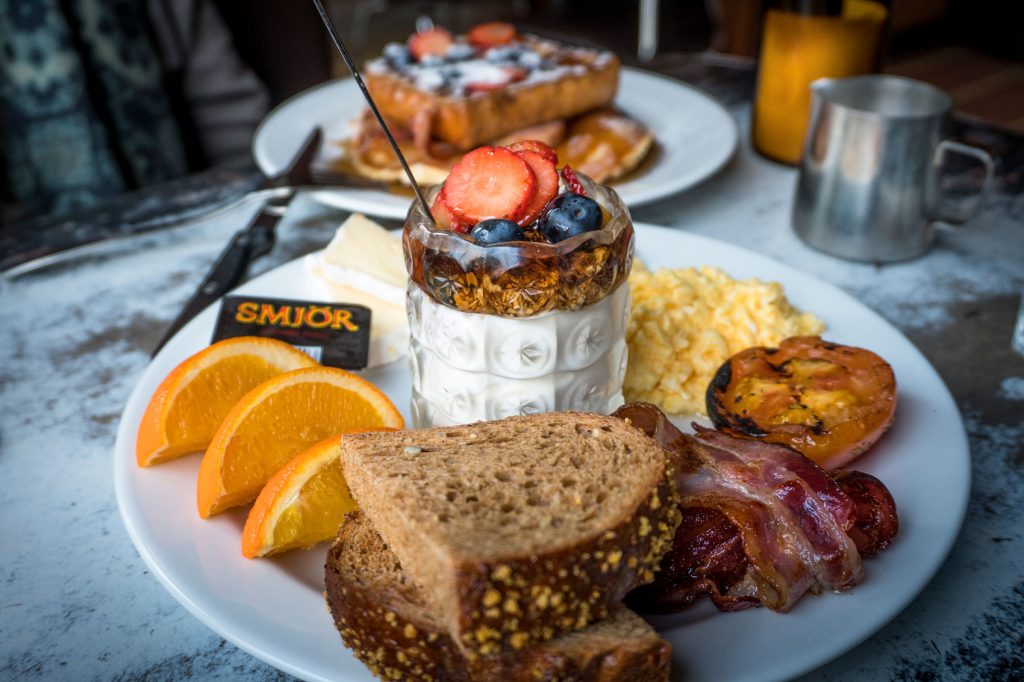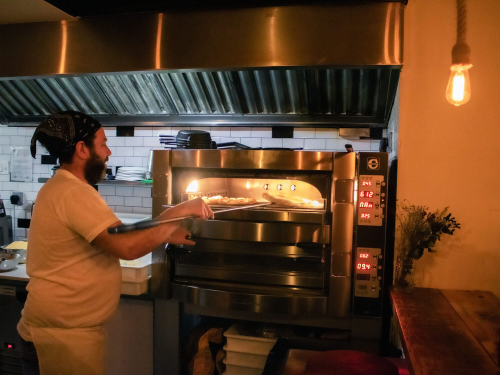
Famously known as the land of fire and ice, Icelandic cuisine is reflective of the intensity and power of its geography, and resilience of its people. Most of this Nordic Island country is covered in rugged mountainous terrain, ice fields, and glaciers that are beautiful, but uninhabitable.
Its first settlers had to learn to survive with the few natural resources they had. Generations and generations of Icelanders have passed down their ancient traditions of food preservation and preparation, with some methods dating back to the 9th century.
As a relatively isolated country, Iceland is a time capsule of tradition. Modern day Iceland has technological advancements and innovations like any other developed country in Europe, but there is something about this country, its people, and cuisine, that are unlike any other in the world.


TINY BUT MIGHTY: ICELAND’S BEGINNINGS
Today, Iceland is the least densely populated country in Europe and only slightly smaller in size than the state of Kentucky. Despite its size, the people of Iceland have quite the mighty history.
Iceland was first inhabited by Irish monks and later by Norse Vikings in the late 9th century. Despite harsh conditions, the settlers survived by primarily fishing, and the settlement grew into a prosperous fishing village.
The island went through many changes under foreign rule by Norway and Denmark, and in1944, Iceland was officially recognized as a Republic.

ANCIENT METHODS OF PRESERVATION
It’s a picturesque and mystical place with a rich culture reflective of ancient traditions and customs. Most Icelanders today are direct descendants of Nordic Vikings that had to learn to thrive in Iceland’s harsh and rough terrain, and this creates an immense amount of pride and desire for preservation of culture. In fact, 93 percent of today’s population of Iceland is Icelandic.
What’s so admirable about this culture is their adherence to tradition. Some of the same foods eaten in the 10th century are still enjoyed today, even prepared the same way, which is a rarity. Visitors to Iceland can take a true step back in time and try some of the ancient methods of cooking, preparing, and preserving foods just as many of our own ancestors practiced thousands of years ago.
As with other Nordic countries, fish was and is today a major staple in the diet of Icelanders. Limited access to salt and other methods of preservation forced early Icelandic settlers to rely on other methods like drying and fermentation.
“It’s a picturesque and mystical place with a rich culture reflective of ancient traditions and customs.”
Fermentation. Fermentation isn’t just a palate pleaser for Icelanders but rather a practice rooted in thousands of years of culture. Fermenting foods like fish or dairy is an effective means of preservation as this method decreases the amount of harmful bacteria in food. It’s also one of the oldest known food preservation methods. The Icelandic dish Hákarl is Greenland shark that has been cured with a fermentation process that involves burying the fish and drying it for months. Greenland shark is poisonous if eaten fresh, so to cure the fish, it would be dried and buried underground for days to ferment. The result is a pungent product that only the older generation and brave tourists eat.
Skyr is a fermented dairy product similar to yogurt that has made its way to the U.S. Skyr is made from fermented skim milk. Early viking settlers used the whey, a byproduct of making skyr, for meat preservation. In Iceland, it’s commonly enjoyed topped with cream, sugar, and sometimes berries.
Drying. Drying removes moisture from food so that bacteria can’t grow and spoil the food. Early Icelandic settlers used this preservation method particularly with white fish like herring or cod since fattier fish like salmon did not dry as well. Icelandic dried fish, akin to “fish jerky” is still a tasty snack enjoyed today. In the past, this dried fish was eaten with butter since bread was nonexistent or scarce at best. Some Icelanders still eat dried fish with butter to soften the texture.
Smoking. Smoking food acts as a preservation method by killing bacteria and drying out the food so less bacteria can grow. Chemicals found in smoke can also act as preservatives.
Icelandic smoked lamb, or hangikjöt, is dry-salted or pickled in a brine solution and then cold-smoked over a fire. It’s commonly eaten as a topping for bread or served as a main dish alongside cooked potatoes, bechamel sauce, peas, and pickled red cabbage.
Pickling. Pickling is the process of preserving food by either anaerobic fermentation in brine or immersion in vinegar. There are many Icelandic dishes that use this preservation method.
Not all these foods are eaten daily; some of these more traditional foods are eaten mostly around holidays or on special occasions.


FARMING & FISHING
Icelandic cuisine can jokingly be placed into two categories: meat and seafood. There is a bit of truth in this. For centuries, people relied on what they had and that was mostly fish (and sea birds) and sheep.
The main export for Iceland today is still fish at 42 percent of total exports, one the country’s major industry is fish processing, and the primary cuisine is fish.
You’ll find some of the freshest, purest meat and seafood in Iceland. Icelanders have perfected farming and fishing practices for centuries. It’s been a part of their history and vital to the survival of the earliest settlers. Today, the main species caught in Icelandic waters are cod, haddock, saithe, golden redfish, herring, mackerel and capelin. Fish farming is a relatively new practice to Iceland.
Icelandic farmers typically raise sheep and cattle. Other livestock include pigs, chickens, and Icelandic horse but it wasn’t until the 20th century that these different types of livestock were brought in.
Other meats eaten by Icelanders are goat, reindeer, horse, and various types of seabirds. Puffin and whale meat aren’t as popular today due to the drops in population. You may find these meats in some restaurants, but they are more controversial.


GEOGRAPHY GROWS RESILIENCE
80 percent of Iceland is completely uninhabitable. There are 30 active volcanoes on the island, little vegetation, many bogs, and moors, as well as hot springs heated by geothermal energy. But instead of waving the white flag, the industrial Icelanders have found ways of embracing their environment and harness the natural power around them, and the outcome is delicious.
The only forests you’ll find in Iceland are birch wood forests. The only naturally growing vegetation are mostly root or cruciferous vegetables like potatoes, leeks, and cauliflower. You won’t see cows roaming green pastures. These restraints, however, only motivate the spirited Icelanders.
In Iceland, many fruits and vegetables can be grown year-round using geothermal powered greenhouses. Most vegetation in Iceland is grown in greenhouses.
Barley is the only known grain to be grown in Iceland; all other grains are not indigenous to the country. Aside from barley, early Icelanders could sometimes acquire rye grain from the Danes. Rye bread was and is today a main staple in their diets. But what’s interesting about early bread making in Iceland is the baking method. Before ovens, Icelanders would use geothermal springs to bake bread. People would take their bread dough and bury it in pots in geothermal springs for 24 hours to bake. Called Hverabrauð, hot springs bread, volcanic lava bread, thunder bread, Icelandic rye bread, or lava bread, this delicious bread is an Icelandic favorite still today.
“The industrial Icelanders have found ways of embracing their environment and harness the natural power around them, and the outcome is delicious.”
LICORICE TAKES THE CAKE AMONG SWEET TREATS
Sugar was not introduced to Iceland until the 19th century. Early Icelanders had no honey, maple syrup, or other ways to sweeten foods so being the industrious people that they are, Icelanders used licorice root as a sweetener. Combine these struggles with decades of candy import bans and restrictions on foreign candies, and you’ll understand what made the Icelandic people reliant on licorice to get their sweet fix.
Iceland’s love of licorice goes beyond the taste. It’s truly a beloved treat that traces its roots back to the very first settlers of the island. The licorice plant doesn’t need to flower to live (remember, no bees so no flowers), and the root portion of the plant is both edible and sweet.
Still today, you’ll find black licorice, or lakkris, in many desserts and snacks. One of the most popular ways to enjoy it is combined with chocolate. Think chocolate covered licorice, licorice brownies, or even over chocolate ice cream.

BLACK DEATH OR BEER: DRINKING IN ICELAND
Though beer has only been allowed in Iceland since 1989 (celebrated annually with Beer Day), there are many local breweries in the capital city. Drinking in Iceland is quite expensive and outside of restaurants, can only be purchased at government regulated liquor stores. If you do imbibe, you’ll find there’s a lot of culture even in what and how Icelanders drink.
Like many other countries, Iceland went through a period of prohibition from about 1915 to 1989. As other types of alcohol became legal, beer was seen as unpatriotic (since there was an association with beer and Denmark), so it remained banned. Sentiment has shifted since the ban, and it’s no longer tabooed to enjoy a pint of beer.
Brennivín, or “Black Death”, is an infamous Icelandic liquor that’s made from fermented grain or potato mash and flavored with caraway. Most locals don’t drink it often, but it’s remained a part of the Icelandic culture since the 17th century.
MODERN DAY CUISINE, ICELANDIC STYLE
Today, you’ll find a lot more than fermented fish when visiting the capital of Iceland. Alongside traditional eateries are Asian, Middle Eastern, and even vegan restaurants. Most of the more traditional foods are enjoyed at festivals like Þorrablót, an Icelandic midwinter festival, or on holidays like bóndadagur, or Husband’s Day which marks the beginning of the old month of Thorri.
Modern technology has evolved more traditional processes with the advent of industrial preservation methods and modern fishing practices. This has changed the way traditional Icelandic cuisine is handled (mainly from a food safety standpoint), but this doesn’t mean that you can’t still find traditional Icelandic dishes on the menus in today’s restaurants.


Related Articles
-
 Travel & Culture March 16, 2020 | 6 min read Significance of Sustenance: Burlington I grew up in the shadow of the slopes in the Pocono Mountains, but the icy Pennsylvania conditions made skiing decidedly unfun for fall-prone little-ol’ me.
Travel & Culture March 16, 2020 | 6 min read Significance of Sustenance: Burlington I grew up in the shadow of the slopes in the Pocono Mountains, but the icy Pennsylvania conditions made skiing decidedly unfun for fall-prone little-ol’ me. -
 Travel & Culture April 02, 2020 | 8 min read A Brooklyn Pizzeria Fights Through COVID-19 COVID-19 hit the city like a slow-moving hurricane. We knew it was coming, but we were still in shock. Everything was uncertain.
Travel & Culture April 02, 2020 | 8 min read A Brooklyn Pizzeria Fights Through COVID-19 COVID-19 hit the city like a slow-moving hurricane. We knew it was coming, but we were still in shock. Everything was uncertain. -
 Travel & Culture June 23, 2020 | 6 min read Distinctive Process: Maori Hangi Steaming geothermal pools set against a vivid blue sky, in the middle of lush natural surroundings and a day spent soaking up indigenous Maori culture.
Travel & Culture June 23, 2020 | 6 min read Distinctive Process: Maori Hangi Steaming geothermal pools set against a vivid blue sky, in the middle of lush natural surroundings and a day spent soaking up indigenous Maori culture.